Galaxy and AGN counts model
Based on the
observed dichotomy in the ages of stellar populations of early-type
galaxies on one side (mass-weighted ages of > 8-9 Gyr and formation
redshifts z > 1-1.5; named proto-spheroidal galaxies which are
progenitors of local massive elliptical galaxies) and late-type
galaxies on the other (luminosity-weighted ages of < 7 Gyr and
formation redshifts z < 1), we have elaborated a comprehensive
''hybrid'' model to investigate the cosmological evolution of the
luminosity function of galaxies and active galactic nuclei (AGNs) in the infrared (IR).
As for proto-spheroids, the physical model proposed by Granato et al. (2004)
for the early coevolution of massive proto-spheroidal galaxies and
active nuclei at their centers, further elaborated by Lapi et al. (2006, 2011),
has been upgraded by working out the epoch-dependent luminosity
functions of sources a a whole (stellar plus AGN component), taking
into account in a self-consistent way the variation with galactic age
of the global SED. Complemented with a phenomenological model for
late-type star-forming galaxies (''warm'' starburst and ''cold'' normal
spiral) and AGNs (type-1 and type-2) associated with them, this ''hybrid'' model can explain multi-wavelengths, i.e.,
from mid-IR to (sub-)millimeter, estimates of the luminosity functions at different
redshifts, of redshift distributions, of number counts, and of the cosmic infrared background.
These presented contents are based on the new
Galaxy and AGN counts model upgraded in ''A hybrid model for the
evolution of galaxies and Active Galactic Nuclei in the infrared'' by
Cai, Z.-Y., Lapi, A., Xia, J.-Q., De Zotti, G., Negrello, M.,
Gruppioni, C., Rigby, E., Castex, G., Delabrouille, J. and Danese, L.
(2013, ApJ, 768, 21 and my PhD thesis for all the details).
In the
following, the adopted SEDs of each component of the model as well as
many comparisions between model and observations are presented. Each all.tar.gz link
contains all the corresponding tabulated files and figures of each part, while separated file can be found through each corresponding link. The
observational data, e.g., LFs or NCs, are also available in IDL save
format.
Spectral energy distributions (SEDs, all.tar.gz)
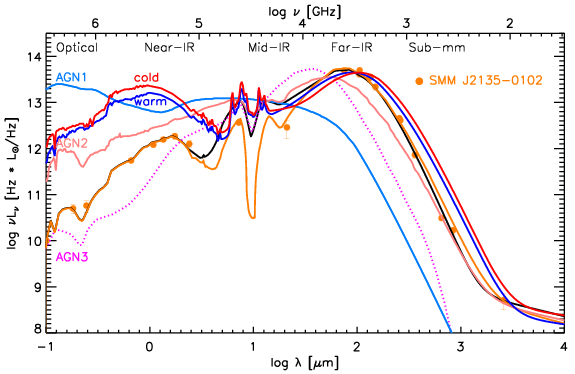 The SEDs adopted for high-z stellar component and AGN component (obscured AGN3 and unobscured) of proto-spheroidal galaxies, for low-z ''warm'' and ''cold'' star-forming galaxies, and for low-z type-1 and type-2 AGNs are shown. The SEDs adopted for high-z stellar component and AGN component (obscured AGN3 and unobscured) of proto-spheroidal galaxies, for low-z ''warm'' and ''cold'' star-forming galaxies, and for low-z type-1 and type-2 AGNs are shown.
The SED of the strongly lensed galaxy SMM J2135-0102, modeled using GRASIL (Silva et al. 1998) and presented in Lapi et al. (2011), is here.
The photometric data of SMM J2135-0102 (Swinbank et al. 2010; Ivison et al. 2010) are available in IDL save format SMM_J2135.save (see readme_SMM for a description of the saved structure). These adopted SEDs are then convolved with filters to obtain the following observable quantities. |
Luminosity functions (more results on LFs, all.tar.gz)
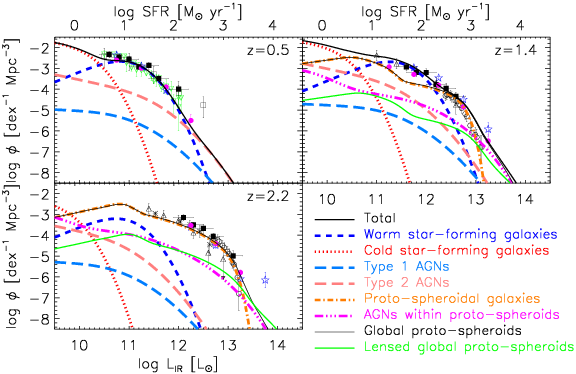 Model: Model:The IR (8-1000 μm), 8, 12, 15, 24, 35, 60, 70, 90, 100, 160, and 250 micron LFs of all populations are tabulated. The local LFs at z=0.05 from 8 to 1380 micron can be found here. The AGN LFs at 0.467 micron (g-band) and 1.241 micron (J-band) are given. Data: They are available in IDL save format LF_IR.save and LFnu.save (see readme_LFdata for a description of the saved structures). |
Redshift distributions (more results on RDs, all.tar.gz)
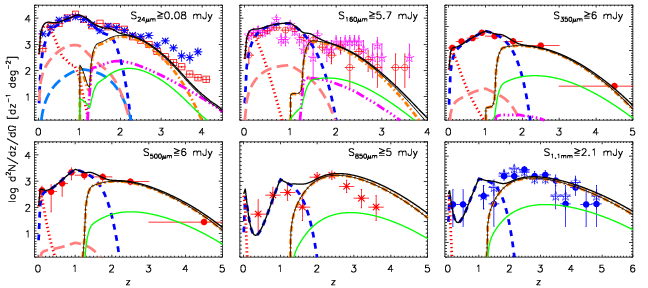 Model: Model:The tabulated redshift distributions are available at 24, 70, 100, 160, 250, 350, 500, 850, and 1100 micron for some flux limits. Data: They are available in IDL save format rd.save (see readme_RDdata for a description of the saved structure). |
Number counts (more results on NCs, all.tar.gz)
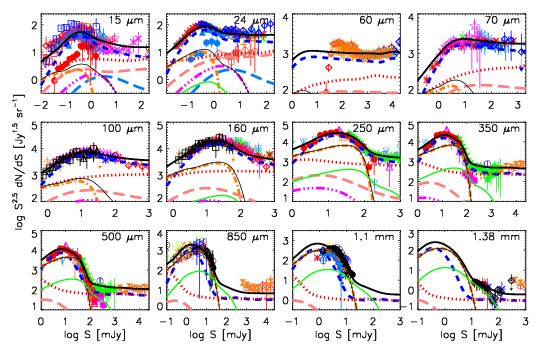 Model: Model:
The Euclidean normalized differential number counts are available at wavelengths from mid-IR to mm: 8, 12, 15, 16, 24, 35, 60, 70, 100, 160, 250, 350, 450, 500, 550, 850, 870, 890, 1100, 1200, 1363.6, 1380, 2000, and 3157.9 micron.
The Euclidean normalized differential number counts per redshift
slices, i.e., [0.0, 0.5], [0.5, 1.0], [1.0, 2.0], [2.0, 8.0], are available
at 24, 70, 100, 160, 250, 350, and 500 micron.
Data: They are available in IDL save format nc_dnc.save and nc_dnc_split.save (see readme_NCdata for a description of the saved structures). |
Cosmic infrared background (more results on CIB, all.tar.gz)
 Model: Model:The tabulated contributions of the different populations to the CIB are available here. The cumulative CIB as a function of flux are available at 70, 100, and 160 micron. |
Angular power spectra (more results on APS, all.tar.gz)
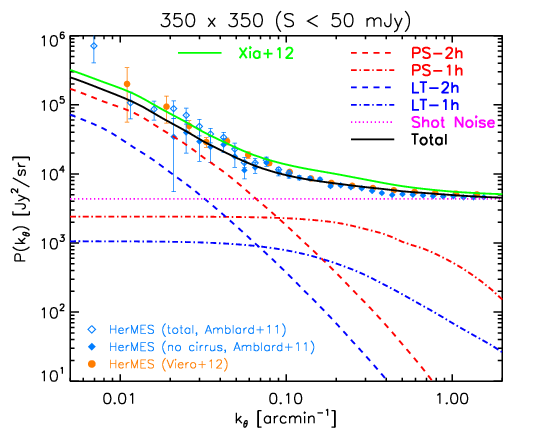 Model: Model:The tabulated
CIB angular power spectra due to clustering of sources fainter than
some flux density limit (say, 50 mJy) at far-IR/sub-mm wavelengths are available at 100, 160, 250, 350, and 500 micron.
The angular power spectra predicted by Xia et al. (2012) which is based on model by Lapi et al. (2011) are also avaiable at 250, 350, and 500 micron.
Data: They are available in IDL save format posp.save (see readme_PSdata for a description of the saved structure). |
Contact
Please send comments or requests to CAI by zcai@sissa.it or zcai.cn@gmail.com. - Last modified: 28/11/2013 (See update history)